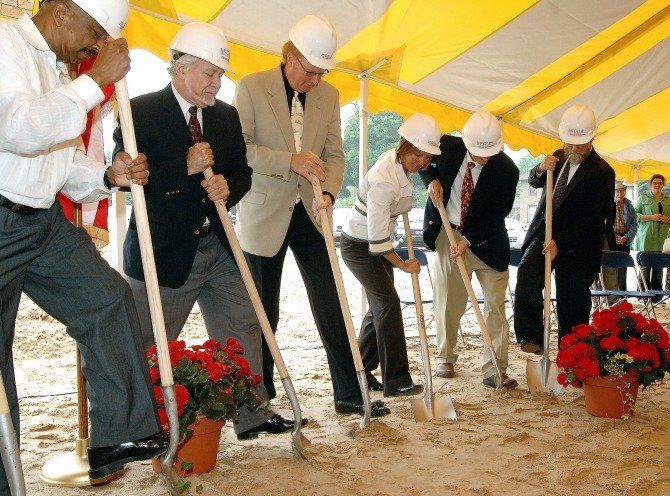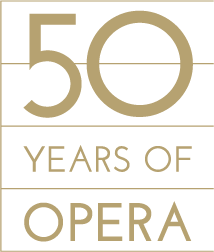This story is part of a series of 50 stories we are releasing to commemorate 50 years of opera in West Michigan. Browse more stories and follow our journey throughout the season.

“Good buildings come from good people and all problems are solved by good design.” – Stephen Gardiner
Have you ever tried sharing a (big) pizza with three friends, only to have the planning phase devolve into bedlam? Toppings are suggested and sneered at, hands are thrown in the air, someone claims they “like everything,” but they don’t. Late in the discussion, someone reveals he’s allergic to pineapple and the mere threat of its presence is enough for him to opt out altogether.
Now imagine you’re ordering a pizza with these friends, but the pizza is about fourteen thousand square feet. It will have 862 toppings, with extra cheese on one slice only, and you have to cook it while stepping over and around a live power line that’s draped across the kitchen. This is, more or less, the story of the Betty Van Andel Opera Center building.
But there’s nothing uniquely byzantine about the saga leading to the Opera Center’s final home on East Fulton Street. False starts, left turns, compromises, and thorny situations are the order of the day in the development and construction game, according to Paul McGraw, President of McGraw Construction. It’s just that most people don’t have a window into the epic prelude to a building’s actual construction.
Like the best stories, the Opera Center’s began humbly, borne of necessity. “Originally, the Opera was almost begging and borrowing spaces to rehearse in. These spaces were generally a landlord who had a large vacant building. Traditionally those are pretty run down spaces. For a while they were rehearsing in an old Fruit Basket Flowerland,” says McGraw. For a time, strip mall patrons carrying Chinese takeout may have cocked their heads, wondering if they really did hear a faint soprano voice issuing from the vacant storefront next to the discount fireworks shop.
The Opera was moving through rehearsal spaces as landlords and availability dictated. While some landlords donated their spaces, others did not. Scheduling was complicated, and the moves themselves were not easy—the Opera staff regularly had to drag its entire costume shop into dusty alcoves and unpack it, only to repeat the process a few days later. The situation ate at OGR’s funds, and tested the resolve of the staff, who had to continue running an opera company as nomads.
In the mid aughts, a group of city luminaries who loved and supported opera, including Carol Van Andel and Paul McGraw, began a development process that would take years. Each board member of the development committee had his or her own idea about the location, and whether a new or existing building should be used. “Altogether, I think we looked at about thirty properties,” says McGraw. “We were trying to find all the right conditions and the right location. Every time we looked at a new location, we had to run the financials behind it. There were huge amounts of moving parts involved.”
With a generous fundraising kickoff from the Van Andel Family, architectural design by the Beta firm, and the expertise of McGraw Construction, the moving parts were assembled into the beautiful contemporary building where the Opera resides today.

“It’s important, from a neighborhood perspective, since you’re making a mark in a neighborhood, to keep people in mind. Architecture is debatable, but it’s important not to forget the human side of things,” says McGraw. They decided on a glass facade, for instance, so that people could see inside. It gives people walking or driving past a sense of connection with their fellow townsfolk working inside. “You’ve driven by buildings that are all boarded up in the front. It’s not very inviting,” he says. When it comes to creating a part of the landscape that will be there for decades, the stakes are high. It’s a really, really serious thing. Even though I’m not that serious of a guy, socially… I am deadly serious when it comes to this business. The effect on the community, on people’s safety, on the minds of people walking by outside, and the effect on the environment, they’re all things you have to consider.”
Making the Opera Center friendly to the environment was no small task, especially in the case of maintaining the rigorous federal LEED—Leadership in Energy and Environmental Design— certification attached to the building. (LEED requires a building meet especially high safety and energy standards, and even takes into account employee well-being metrics, like how much natural daylight reaches employees.)
At the end of a long journey, there stands a 14,000 square foot, environmentally-friendly rehearsal and office space. It’s a permanent testament to the vision of all those who made it possible, like the Jay and Betty Andel Foundation, former Executive Director John Peter “Jeep” Jeffries, Paul McGraw, and countless others.
In addition to serving as the nerve center of opera operations, the Opera Center is a venue in its own right. October of 2016 saw the Center hosting its first opera performance: Maria de Buenos Aires. The show sold out and received great reviews. Afterward, Opera Grand Rapids installed theater seating, ensuring that future performances in the space would provide patrons the comfort and experience they deserve. Meanwhile, the Opera Center has also been hosting diverse and intimate recitals, from New York’s Polydora Ensemble to the Opera Grand Rapids Emerging Artists.

The Opera Center’s main attraction, The Violet Wondergem Rehearsal Hall, is open to the public for rental. High ceilings, generous daylight, and bamboo flooring bring a warm, natural feeling to performances and rehearsals alike.
Opera Grand Rapids plans to bring a series of engaging performances, grand and small, to the Opera Center stage, and open its doors to the community as often as possible over the coming seasons. The Opera Center is a space for gathering, creating, and celebrating. The years ahead will see the space embodying the vision of those who worked so hard to make it a reality.

OUR FOUNDERS HAD A BOLD PROPOSITION: to build a professional opera company that would put Grand Rapids on the map for a very discerning audience. 50 years later, we are humbled to be the modern bearers of classical standards and modern ingenuity. Learn more.
SUPPORT OUR NEXT 50 YEARS
As an integral part of our city’s artistic fabric, it’s our responsibility to see to its continual flourishing. Please consider donating to Opera Grand Rapids to ensure our artistic excellence for the next 50 years and beyond. You’ve already made us great. With your support, there’s no limits to the height our voices can reach together. Give today.

